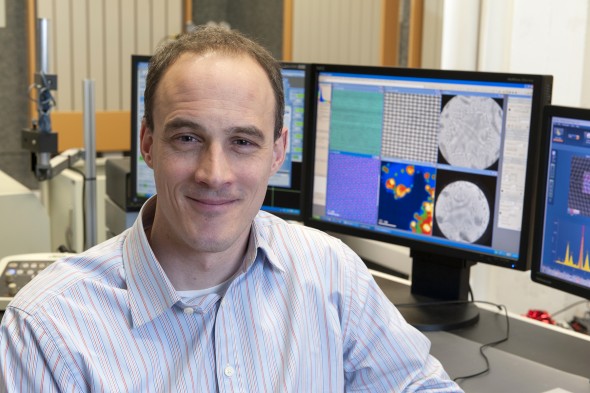Taking it down to the atomic level with electron microscopy

Robert Klie: “We try to understand what the boundaries look like, how the boundaries can be improved.” Photo: Roberta Dupuis-Devlin/UIC Photo Services
The Researcher of the Year Award recognizes 10 UIC scientists who are advancing knowledge in their fields. The Distinguished Researcher Award honors five researchers with a record of outstanding achievement. The Rising Star Award honors early-career researchers who show promise as future leaders.
NATURAL SCIENCES & ENGINEERING
Robert Klie
Rising Star
What do batteries, solar cells and tooth enamel have in common? Robert Klie explores the structure of these materials at the atomic level to find out.
Klie, associate professor of physics, completed his Ph.D. at UIC, then returned as a faculty member in 2007 because “UIC has a long history of outstanding microscopy.”
He led the effort to bring a state of the art scanning transmission electron microscope to the campus. “It is one of the highest-resolution instruments in the U.S.,” he says. “It’s allowed us to look at the atomic structure of materials with relative ease.”
In 2013, Klie and his lab developed a groundbreaking technique to determine the atomic structure of materials in their native liquid environment. The technique sandwiches the sample between two single, extremely thin layers of graphene, which protects the material from the high energy of the electron beam.
By understanding exactly what’s happening at the atomic level, Klie wants to improve the materials used in batteries, solar cells and catalysts in fuel. He looks at the boundaries between the individual pieces of a material, comparing it to a building made up of individual bricks held together by mortar.
“If the building breaks down, it will probably be between the mortar lines. We try to understand what the boundaries look like, how the boundaries can be improved and then how we can make them more efficient. And we can only do this by looking at the atomic structure.”
The graphene liquid cell may help answer fundamental biology questions. Previously, biological samples were frozen, then sliced into thin sections for electron microscopy. Now they can be studied in their natural, living state.
Klie’s work has received wide attention in the material sciences field, including 14 publications and 10 invited talks last year. He founded and edits the peer-reviewed Journal of Undergraduate Research at UIC “to get students involved in publishing.”
